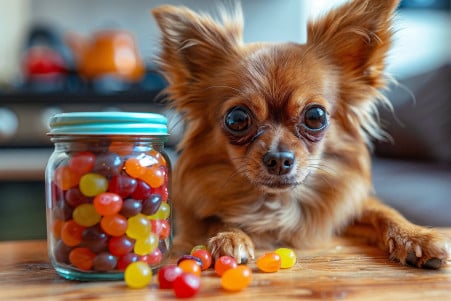Can Dogs Have Jelly? What You Need to Know About Sugary Snacks
7 February 2024 • Updated 7 February 2024

If you’ve ever wanted to give your dog a taste of your favorite sweet treat, you may have wondered if jelly is safe for dogs. However, jelly is not safe for dogs to eat because it often contains xylitol, a toxic ingredient, and high sugar content, which can lead to obesity and diabetes. In addition, many store-bought jellies contain artificial preservatives and sweeteners that can be dangerous for dogs.
This article will cover veterinary research, nutritional information, and expert opinions to outline the dangers and considerations of giving dogs jelly. By the end, you will have a thorough understanding of what dogs need in their diets and how human foods like jelly can negatively impact their health. This information will help you make better choices about which treats are safe for your dog, so you can keep them healthy and happy.
Can dogs have jelly?
Finding the Right Mix: Nutritional Needs and Indulgences in Your Dog’s Diet
As with humans, dogs have specific nutritional needs that must be met to ensure they live a long and healthy life. The Clinical Nutrition Service at Cummings School explains that dogs require proteins and amino acids to build and maintain muscle, fats and fatty acids to maintain a healthy coat, and minerals and vitamins to help with a variety of bodily functions.
In addition, the Association of American Feed Control Officials (AAFCO) has established standards to make sure that pet food and treats are nutritionally complete and balanced.
Although treats can’t replace a well-rounded diet, they can be a helpful addition if used in the right way. VCA Animal Hospitals advises that treats should be used to supplement a dog’s regular diet, providing variety and fun without sacrificing nutrition. As PetMD points out, treats should make up no more than 10% of a dog’s daily caloric intake to ensure that they maintain a healthy diet.
It’s important to make sure that the treats you choose meet these nutritional standards. If treats are given too freely, they can lead to nutritional imbalances that can cause health problems.
While it’s important to recognize the important role that treats can play in training and bonding, it’s also important to be aware of the ingredients in the treats you choose and the potential problems that can be caused by sugar and artificial sweeteners, which we will discuss in more detail.
The Hazards of Sugar and Artificial Sweeteners for Dogs
While dogs may enjoy the taste of sugar, it can have a number of negative health effects, including contributing to obesity and diabetes, according to PetMD. In addition to causing metabolic changes and tooth decay, consuming too much sugar can also lead to pancreatitis.
Meanwhile, artificial sweeteners can be even more dangerous, with xylitol, a sweetener that is often used in jelly, being particularly harmful to dogs. According to Trupanion, xylitol consumption can lead to hypoglycemia, seizures, and even death.
PetMD notes that xylitol poisoning in dogs is so common that it has become a major concern, and it urges dog owners to seek veterinary care immediately if they suspect their pet has ingested xylitol. This is especially important because both sugar and artificial sweeteners are common ingredients in many household products.
MasterClass warns against giving pets sugar because of the health risks associated with it and urges pet owners to be mindful of the treats they choose.
To protect their pets, pet parents should be aware of the regulations surrounding sweeteners in pet food, read labels carefully, and talk to their veterinarians before giving their dogs any new treats. This way, they can ensure that they are making the best choices for their pets and keeping them safe from the dangers of sugar and artificial sweeteners.
The Bottom Line: Why Jelly Is Bad for Dogs
Despite its sweet and harmless appearance, jelly contains several ingredients that can be harmful to dogs. Both Canine Bible and DogTime note that the biggest issue with jelly is its high sugar content, with every tablespoon containing up to 2 teaspoons of sugar. This can lead to obesity, dental issues, and even diabetes.
In addition, the artificial sweetener xylitol, which is toxic to dogs even in small amounts, can be found in jelly and is often masked by fruit flavors.
Jelly also has a poor nutritional profile, with little to no vitamins and minerals and any potential nutrients being cooked out during the jelly-making process. In addition, Canine Bible explains that jelly is devoid of essential nutrients like protein, fiber, and healthy fats, making it an inappropriate snack for dogs.
Even though some homemade jelly recipes may seem safe, pet parents should still be wary. It’s important for pet parents to make sure that the ingredients they use are safe for dogs and don’t include grapes and raisins, which are toxic to dogs. Jelly made from fruit and vegetable purees or powders can be a good occasional treat, as long as it’s free of added sugars and artificial ingredients, as recommended.
Veterinarians and pet nutritionists all agree that pet parents should avoid giving jelly to their dogs. As pet parents, it’s important to think about other options that are better for our dogs’ dietary requirements and will help them live healthier lives.
Healthy Alternatives: Other Treats Dogs Can Eat
While jelly is definitely a no-go for your dog, there are many other healthy and delicious options to choose from. Abbie Cooke, a vet at Raleigh Veterinary, recommends fruits and vegetables like apples, green peas, carrots, green beans, and blueberries as great treats. These options are full of vitamins and fiber, which can help supplement your dog’s diet without the added sugar and calories found in jelly.
PetMD also suggests treats like peanut butter popsicles and sweet potato jerky, which are not only delicious for your dog but also provide important nutrients.
When you’re introducing these treats, make sure to start with small amounts to see how your dog reacts and to prevent any tummy troubles. It’s also important to remember that portion control is key. Even healthy treats should make up no more than 10% of your dog’s daily caloric intake, according to Petco. Healthy treats should also be in addition to a balanced diet, not in place of it.
Always make sure to consult with a vet before making any changes to your dog’s diet or introducing new foods. A vet can offer personalized recommendations to make sure your dog’s nutritional needs are being met while they enjoy a variety of healthy and safe treats.
Conclusion
The above exploration of dog nutrition makes one thing clear: jelly is not a good option for dogs. In addition to the high sugar content, Canine Bible points out that jelly can contain xylitol and other toxic ingredients. On top of that, jelly lacks essential nutrients like protein, fiber, and healthy fats.
While sugar isn’t toxic to dogs, PetMD explains that too much sugar can lead to obesity, metabolic changes, and diabetes. In addition, treats should only make up 10% of a dog’s diet. Because of these issues, it’s important to stick to a dog’s nutritional needs to ensure they stay healthy and avoid the problems that come with poor nutrition.
It’s up to us as pet parents to always put our dogs’ health first. This includes working with veterinarians to get personalized nutritional information that takes our dogs’ specific needs into account.
We also need to take our roles as pet parents seriously and make sure we’re always making the best, most compassionate choices about the food and treats we give our dogs. This way, we can ensure that our dogs live long, healthy lives.


